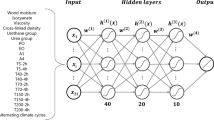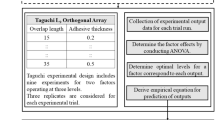The purpose of this study was to develop artificial neural network (ANN) and multiple linear regression (MLR) models that are capable of predicting the bonding strength of wood based on moisture content, open assembly time and closed assembly time of the joints prior to pressing process. For this purpose, the experimental studies were conducted and the models based on the experimental results were set up. As a result of the experiments conducted, it was observed that bonding strength first increased and then decreased with increasing the wood moisture content and adhesive open assembly time. In addition, the increased closed assembly time caused a decrease in bonding strength of wood. The ANN results were compared with the results obtained from the MLR model to evaluate the models’ predictive performance. It was found that the ANN model with the R 2 value of 97.7% and the mean absolute percentage error of 3.587% in test phase exhibits higher prediction accuracy than the MLR model. The comparison results confirm the feasibility of ANN model in terms of predictive performance. Consequently, it can be said that ANN is an effective tool in predicting wood bonding strength, and quite useful instead of costly and time-consuming experimental investigations.






Similar content being viewed by others
References
P. Hass, O. Kläusler, S. Schlegel, and P. Niemz, “Effects of mechanical and chemical surface preparation on adhesively bonded wooden joints,” Int. J. Adhes. Adhes., 51, 95–102 (2014).
I. Horman, S. Hajdarević, S. Martinović, and N. Vukas, “Stiffness and strength analysis of corner joint,” Tech. Technol. Educ. Ma., 5, 48–53 (2010).
A. Sonmez, M. Budakci, and M. Bayram, “Effect of wood moisture content on adhesion of varnish coatings,” Sci. Res. Essays, 4, No. 12, 1432–1437 (2009).
C. B. Vick, Adhesive Bonding of Wood Materials, in: Wood Handbook: Wood as an Engineering Material, Ch. 9, FPL-GTR-113, Madison, WI (1999), pp. 9.1–9.24.
M. L. Selbo, Adhesive Bonding of Wood, Technical Bulletin No. 1512, USDA, Washington, DC (1975).
D. Minelga and V. Norvydas, “Properties of halogensilane modified poly(vinyl acetate) dispersion,” Mater. Sci. (Medþiagotyra), 11, No. 2, 146–149 (2005).
D. F. Cook, C. T. Ragsdale, and R. L. Major, “Combining a neural network with a genetic algorithm for process parameter optimization,” Eng. Appl. Artif. Intel., 13, No. 4, 391–396 (2000).
F. G. Fernandez, P. de Palacios, L. G. Esteban, et al., “Prediction of MOR and MOE of structural plywood board using an artificial neural network and comparison with a multivariate regression model,” Compos. Part B – Eng., 43, No. 8, 3528–3533 (2012).
B. Khalilmoghadam, M. Afyuni, K. C. Abbaspour, et al., “Estimation of surface shear strength in Zagros region of Iran – A comparison of artificial neural networks and multiple-linear regression models,” Geoderma, 153, 29–36 (2009).
L. G. Esteban, F. G. Fernandez, and P. de Palacios, “Prediction of plywood bonding quality using an artificial neural network,” Holzforschung, 65, 209–214 (2011).
U. Atici, “Prediction of the strength of mineral admixture concrete using multivariable regression analysis nd an artificial neural network,” Expert Syst. Appl., 38, 9609– 9618 (2011).
T. A. Choudhury, N. Hosseinzadeh, and C. C. Berndt, “Improving the generalization ability of an artificial neural network in predicting in-flight particle characteristics of an atmospheric plasma spray process,” J. Therm. Spray Technol., 21, No. 5, 935–949 (2012).
G. Aydin, I. Karakurt, and C. Hamzacebi, “Artificial neural network and regression models for performance prediction of abrasive waterjet in rock cutting,” Int. J. Adv. Manuf. Tech., 75, 1321–1330 (2014).
V. A. Boguslaev, A. G. Sakhno, V. K. Yatsenko, and N. V. Gonchar, “Fatigue strength prediction of KhN73MBTYu-VD alloy compressor disks,” Strength Mater., 31, No. 4, 424–428 (1999).
M. M. F. Zain, and S. M. Abd, “Multiple regression model for compressive strength prediction of high performance concrete,” J. Appl. Sci., 9, No. 1, 155–160 (2009).
B. B. Adhikari, and H. Mutsuyoshi, “Prediction of shear strength of steel fiber RC beams using neural networks,” Constr. Build. Mater., 20, 801–811 (2006).
V. K. Singh, D. Singh, and T. N. Singh, “Prediction of strength properties of some schistose rocks from petrographic properties using artificial neural networks,” Int. J. Rock Mech. Min., 38, 269–284 (2001).
A. T. Seyhan, G. Tayfur, M. Karakurt, and M. Tanoglu, “Artificial neural network (ANN) prediction of compressive strength of VARTM processed polymer composites,” Comp. Mater. Sci., 34, 99–105 (2005).
L. G. Esteban, F. G. Fernandez, and P. de Palacios, “MOE prediction in Abies pinsapo Boiss. timber: Application of an artificial neural network using non-destructive testing,” Comput. Struct., 87, 1360–1365 (2009).
F. Eslah, A. A. Enayati, M. Tajvidi, and M. M. Faezipour, “Regression models for the prediction of poplar particleboard properties based on urea formaldehyde resin content and board density,” J. Agric. Sci. Technol., 14, 1321–1329 (2012).
S. Tiryaki and A. Aydin, “An artificial neural network model for predicting compression strength of heat treated woods and comparison with a multiple linear regression model,” Constr. Build. Mater., 62, 102–108 (2014).
S. Tiryaki, S. Ozsahin, and I. Yildirim, “Comparison of artificial neural network and multiple linear regression models to predict optimum bonding strength of heat treated woods,” Int. J. Adhes. Adhes., 55, 29–36 (2014).
K. Watanabe, H. Korai, Y. Matsushita, and T. Hayashi, “Predicting internal bond strength of particleboard under outdoor exposure based on climate data: comparison of multiple linear regression and artificial neural network,” J. Wood Sci., 61, 151–158 (2015).
BS EN 205: 1991. Test Methods for Wood Adhesives for Non-Structural Applications. Determination of Tensile Bonding Strength of Lap Joints, BSI, London (1991).
H. Tabari, A. Sabziparvar, and M. Ahmadi, “Comparison of artificial neural network and multivariate linear regression methods for estimation of daily soil temperature in an arid region,” Meteorol. Atmos. Phys., 110, 135–142 (2011).
S. Kalayci, SPSS Practical Multivariate Statistical Techniques, Asil Publishing Distribution, Ankara (2010).
S. Haykin, Neural Networks: A Comprehensive Foundation, Macmillan, New York (1994).
J. Li, Y. K. Jia, N. Y. Shen, et al., “Effect of grinding conditions of a TC4 titanium alloy on its residual surface stresses,” Strength Mater., 47, No. 1, 2–11 (2015).
V. T. Troshchenko, L. A. Khamaza, V. A. Apostolyuk, and Yu. N. Babich, “Strain– life curves of steels and methods for determining the curve parameters. Part 2. Methods based on the use of artificial neural networks,” Strength Mater., 43, No. 1, 1–14 (2011).
S. Tiryaki and C. Hamzaçebi, “Predicting modulus of rupture (MOR) and modulus of elasticity (MOE) of heat treated woods by artificial neural networks,” Measurement, 49, 266–274 (2014).
T. Varol, A. Canakci, and S. Ozsahin, “Prediction of the influence of processing parameters on synthesis of Al2024-B4C composite powders in a planetary mill using an artificial neural network,” Sci. Eng. Compos. Mater., 21, No. 3, 411–420 (2014).
G. Cybenko, “Approximation by superposition of a sigmoidal function,” Math. Control Signal, 2, 303–314 (1989).
K. Hornik, M. Stinchcombe, and H. White, “Multilayer feedforward networks are universal approximators,” Neural Networks, 2, 359–366 (1989).
C. Hamzaçebi, D. Akay, and F. Kutay, “Comparison of direct and iterative artificial neural network forecast approaches in multi-periodic time series forecasting,” Expert Syst. Appl., 36, 3839–3844 (2009).
I. Kaastra and M. Boyd, “Designing a neural network for forecasting financial and economic time series,” Neurocomputing, 10, 215–236 (1996).
H. R. Maier, A. Jain, G. C. Dandy, and K. P. Sudheer, “Methods used for the development of neural networks for the prediction of water resource variables in river systems: current status and future directions,” Environ. Model. Softw., 25, 891–909 (2010).
R. Baratti, B. Cannas, A. Fanni, et al., “River flow forecast for reservoir management through neural networks,” Neurocomputing, 55, No. 3, 421–437 (2003).
A. J. Panshin and C. de Zeeuw, Textbook of Wood Technology, McGraw-Hill, New York (1980).
E. Güntekin, and T. Y. Aydin, “Effects of moisture content on some mechanical properties of Turkish Red pine (Pinus brutia Ten.),”in: Proc. of the International Caucasian Forestry Symposium (Oct. 24–26, 2013, Artvin, Turkey), pp. 878–883.
M. Nocetti, M. Brunetti, and M. Bacher, “Effect of moisture content on the flexural properties and dynamic modulus of elasticity of dimension chestnut timber,” Eur. J. Wood Prod., 73, 51–60 (2015).
C. D. Lewis, International and Business Forecasting Methods, Butterworths, London (1982).
P. Williams and K. Norris (Eds.), Near-Infrared Technology: in the Agricultural and Food Industries, 2nd edn, American Association of Cereal Chemists, St. Paul, MN (2001), p. 143.
J. H. Cheng and D. W. Sun, “Recent applications of spectroscopic and hyperspectral imaging techniques with chemometric analysis for rapid inspection of microbial spoilage in muscle foods,” Compr. Rev. Food Sci. F., 14, 478–490 (2015).
A. T. C. Goh and W. G. Zhang, “An improvement to MLR model for predicting liquefaction induced lateral spread using multivariate adaptive regression splines,” Eng. Geol., 170, 1–10 (2014).
G. K. Uyanik and N. Güler, “A study on multiple linear regression analysis,” Proc. Soc. Behav. Sci., 106, 234–240 (2013).
Author information
Authors and Affiliations
Corresponding author
Additional information
Translated from Problemy Prochnosti, No. 6, pp. 95 – 110, November – December, 2016.
Rights and permissions
About this article
Cite this article
Bardak, S., Tiryaki, S., Bardak, T. et al. Predictive Performance of Artificial Neural Network and Multiple Linear Regression Models in Predicting Adhesive Bonding Strength of Wood. Strength Mater 48, 811–824 (2016). https://doi.org/10.1007/s11223-017-9828-x
Received:
Published:
Issue Date:
DOI: https://doi.org/10.1007/s11223-017-9828-x




